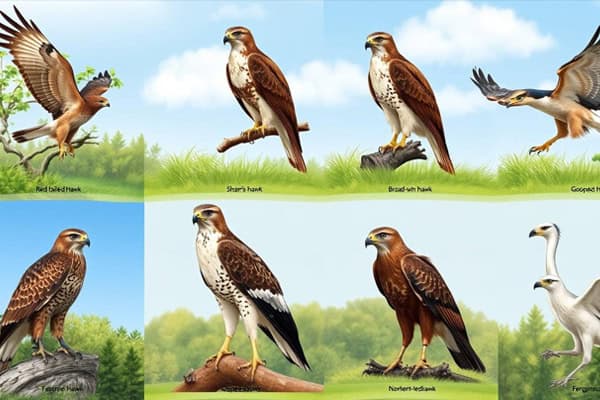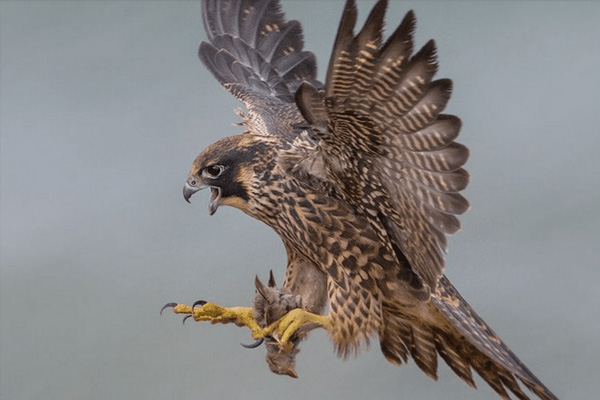Hawks in Massachusetts (8 Common & Rare Species) ID Guide
Did you know Massachusetts has about 8 hawks and falcon species? These birds attract bird watchers and nature lovers from everywhere. They can fly up to 60 miles per hour and have wings almost 5 feet wide!
In this guide, we’ll examine the amazing hawks in Massachusetts. We’ll learn about common hawks like the Red-tailed Hawk and rare ones like the Rough-legged Hawk. We aim to improve our hawk-spotting skills so we can enjoy their beauty and importance in our environment. Let’s start this bird-watching adventure together!
Introduction to Hawks in Massachusetts
Thanks to its many hawks, Massachusetts is a great place for bird-watching. We’ll learn about both migratory and resident hawks, which add to the state’s wildlife all year round.
Bird watching in Massachusetts lets us see many hawks in the sky. Places like the Connecticut River Valley and Mount Tom are favorites. They’re especially good in September when hawk watching is at its best.
At Quabbin Reservoir, you can see Bald and Golden Eagles in winter. Blueberry Hill in West Granville is great for Broad-winged Hawks. And Mount Wachusett State Reservation is perfect for those near Boston.
In southern New Hampshire, Pack Monadnock is a top bird-watching spot. Coastal areas like Salisbury Beach State Reservation and Parker River National Wildlife Refuge are also great. The Great Meadows National Wildlife Refuge in Concord is another favorite for hawk sightings.
Hawk migration and sightings change every day, depending on the weather. Knowing the best times and places makes bird-watching more fun. Each part of Massachusetts has its own hawk habitats, from mountains to coast.
Exploring Massachusetts wildlife means discovering the many hawks that live here. Let’s enjoy bird watching together and learn about these amazing birds.
Types of Hawks Found in Massachusetts
In Massachusetts, we find many hawks, mainly Accipiters and Buteos. Each group has special traits that help us know them and how they hunt.
Accipiters are fast and thin and great at catching small birds. They fly through thick plants to hunt. The Cooper’s Hawk is one of them. It’s medium-sized with a gray back, reddish chest, and reddish eyes. Young ones have brown backs and white bellies with brown streaks.
Buteos are bigger and stronger, with wider wings. The Red-tailed Hawk is well-known. It’s 18 to 26 inches tall, with a wingspan of 43 to 55 inches. They soar high, showing off their red tails and pale bellies. There are many types of Buteos, making them interesting to watch.
Both Accipiters and Buteos add to the variety of hawks in Massachusetts. They make birdwatching exciting as we try to spot these amazing birds.
| Hawk Species | Type | Length | Weight | Wingspan |
|---|---|---|---|---|
| Cooper’s Hawk | Accipiter | 13½ – 20 inches | 8 – 24 oz | 24½ – 35½ inches |
| Red-tailed Hawk | Buteo | 18 – 26 inches | 1.5 – 3.5 lbs | 43 – 55 inches |
| Sharp-shinned Hawk | Accipiter | 9 – 13.5 inches | 3 – 8 oz | 16.5 – 26.5 inches |
| Red-shouldered Hawk | Buteo | 15 – 19 inches | 1.1 – 1.9 lbs | 38 – 42 inches |
| Northern Goshawk | Accipiter | 16 – 27 inches | 22 – 50 oz | 35 – 50 inches |
Most Common Hawks in Massachusetts
We look at the five most common hawks in Massachusetts. Knowing these birds makes birdwatching more fun. It helps us understand their unique traits and how they act.
1. Red-tailed Hawk
- Scientific Name: Buteo jamaicensis
- Size: 45–65 cm (18–26 in)
- Weight: 0.6–1.4 kg (1.3–3.1 lb)
- Diet: Primarily small mammals, birds, and reptiles
The Red-tailed Hawk is often seen, making up over 16% of sightings. They have a strong build and a reddish tail. These birds like open fields, hills, and woodlands, making them easy to spot.
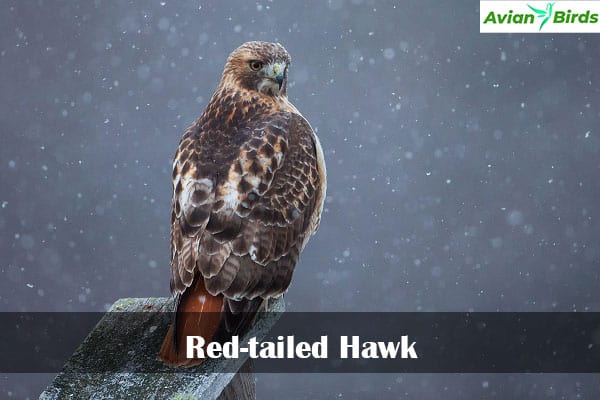
2. Cooper’s Hawk
- Scientific Name: Accipiter cooperii
- Size: 36–51 cm (14–20 in)
- Weight: 0.5–1.2 kg (1.1–2.6 lb)
- Diet: Primarily birds, but also small mammals and reptiles
The Cooper’s Hawk is also common and found near cities and homes. It makes up about 5% of sightings. These hawks are great at catching small birds and are easy to see in trees and feeders in fall and winter.
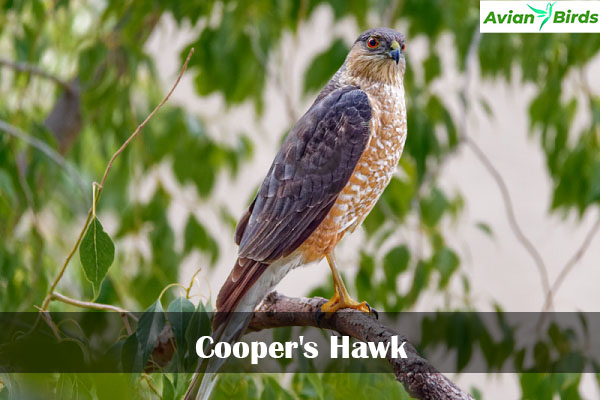
3. Red-shouldered Hawk
- Scientific Name: Buteo lineatus
- Size: 40–63 cm (16–25 in)
- Weight: 0.5–1.4 kg (1.1–3.1 lb)
- Diet: Primarily small mammals, birds, and amphibians
The Red-shouldered Hawk is less common but still seen often. They like wooded areas and are known for their call and beautiful feathers.
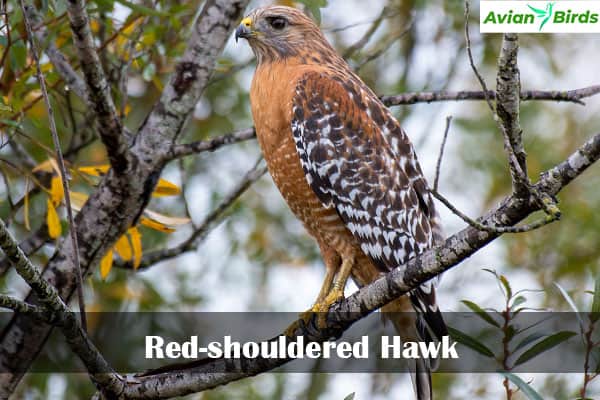
Must visit: Hawks Species in San Diego
4. Sharp-shinned Hawk
- Scientific Name: Accipiter striatus
- Size: 28–38 cm (11–15 in)
- Weight: 60–200 g (2.1–7.1 oz)
- Diet: Primarily small birds, but also insects and small mammals
The Sharp-shinned Hawk is seen in about 2% of observations. Like the Cooper’s Hawk, it is seen in backyards and around feeders, especially during migrations. Its small size and fast flight make it interesting to watch.

5. Broad-winged Hawk
- Scientific Name: Buteo platypterus
- Size: 32–43 cm (13–17 in)
- Weight: 0.5–1.4 kg (1.1–3.1 lb)
- Diet: Primarily small mammals, birds, and amphibians
The Broad-winged Hawk is the last on our list, seen in less than 1.5% of sightings. These hawks nest in large forests and migrate in flocks during certain seasons.
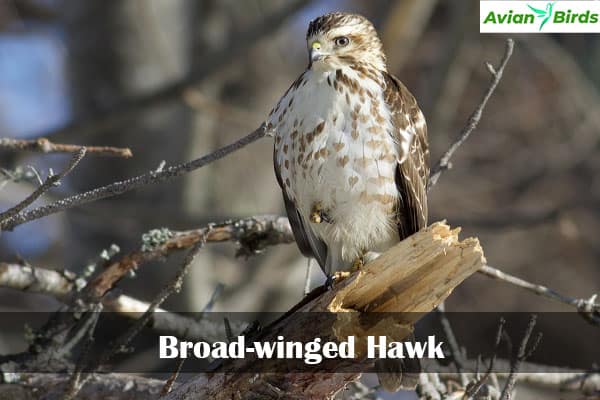
Learning about these hawks makes birdwatching more enjoyable. Whether it’s a Red-tailed Hawk flying high or a Cooper’s Hawk darting through trees, it’s always exciting.
| Hawk Species | Percentage of Sightings | Preferred Habitat |
|---|---|---|
| Red-tailed Hawk | 16% | Open fields, hills, woodlands |
| Cooper’s Hawk | 5% | Urban areas, residential neighborhoods |
| Red-shouldered Hawk | N/A | Wooded habitats |
| Sharp-shinned Hawk | 2% | Backyards, feeders |
| Broad-winged Hawk | Less than 1.5% | Large forests |
Rare Hawk Species in Massachusetts
In Massachusetts, bird watching often focuses on common birds. But this state also has rare hawks. The Rough-legged Hawk and the northern goshawk are two rare species to look for. Each has unique traits and behaviors.
6. Rough-legged Hawk
- Scientific Name: Buteo lagopus
- Size: 45–60 cm (18–24 in)
- Weight: 0.7–2.0 kg (1.5–4.4 lb)
- Diet: Primarily small mammals, especially lemmings and voles
The Rough-legged Hawk is a striking sight in winter. It migrates south from the Arctic. It’s known for its “kiting” hunting style, hovering in place to scan the ground for prey.
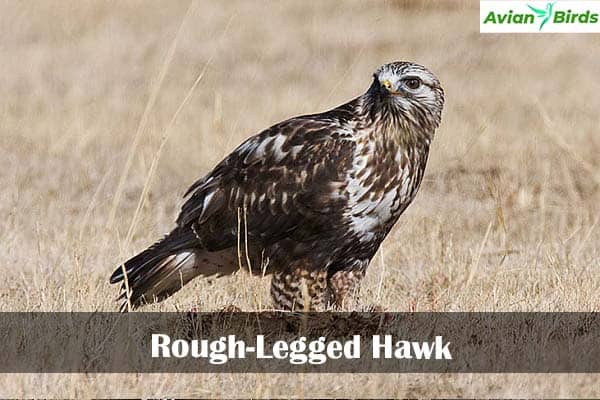
It has light and dark morphs, showing a mix of colors. This makes it a delightful sight for bird watchers.
Must read: Hawks in Hawaii
7. Northern Goshawk
- Scientific Name: Accipiter gentilis
- Size: 48–66 cm (19–26 in)
- Weight: 0.7–2.0 kg (1.5–4.4 lb)
- Diet: Primarily birds and small mammals
The Northern Goshawk is less seen but just as captivating. It’s big and aggressive. These hawks live in dense, mature forests, making them rare to see.

They have a striking appearance and fiercely defend their nesting territories, which attracts bird watchers who are looking for an extraordinary sighting.
| Hawk Species | Migration Period | Common Habitat | Key Identification Features |
|---|---|---|---|
| Rough-legged Hawk | Winter | Open fields, wetlands | Kiting behavior, light, and dark morphs |
| Northern Goshawk | The year-round breeding season peaks in spring | Mature forests | Large size, aggressive territorial behavior |
Identifying Hawks in Massachusetts
Identifying hawks can be tricky because they look different and are hard to spot. We will look at important field marks and behaviors to help us tell hawks apart. Knowing these things makes birdwatching fun and helps us appreciate these amazing birds.
Field Marks to Look For
Field marks are key to telling hawk species apart. Look for:
- Coloration: The color of their feathers is very important. Many hawks have unique patterns and colors.
- Tail Shape: The shape of their tail can tell you what kind of hawk it is. Buteos have round tails, while Accipiters have square tails.
- Wing Structure: The shape and length of their wings help identify them. Buteos have wide wings for soaring, while Accipiters have narrow, pointed wings for flying through trees.
- Size: Knowing how big they are helps us compare them.
Behavioral Characteristics
Watching how hawks behave can also help us identify them. Important behaviors to look for include:
- Hunting Methods: Hawks hunt in different ways. Some soar high to scan the ground, while others sneak up on prey from a tree.
- Nesting Sites: Hawks often nest in the same places. Knowing where they like to nest can help us find them.
- Migration Patterns: Some hawks migrate at certain times of the year. For example, Broad-winged Hawks fly in big groups in the fall.
| Species | Life Span | Size (inches) | Weight (oz) | Wingspan (inches) |
|---|---|---|---|---|
| Red-Tailed Hawk | 10-15 years | 19.7-25.6 | 31.8-51.5 | 44.9-52.4 |
| Cooper’s Hawk | 12 years | 14.6-15.3 | 7.8-14.5 | 24.4-35.4 |
| Sharp-Shinned Hawk | 5 years | 9.4-13.4 | 3.1-7.7 | 16.9-22.1 |
| Broad-Winged Hawk | 12 years | 13.4-17.3 | 9.3-19.8 | 31.9-39.4 |
| Rough-legged Hawk | Up to 15 years | 18-20 | 24-52 | 52-54 |
Best Time and Places for Hawk-Watching
September is the best month for bird-watching in Massachusetts. Broad-winged Hawks gather in large numbers during the fall migration, and watching them soar is truly amazing.
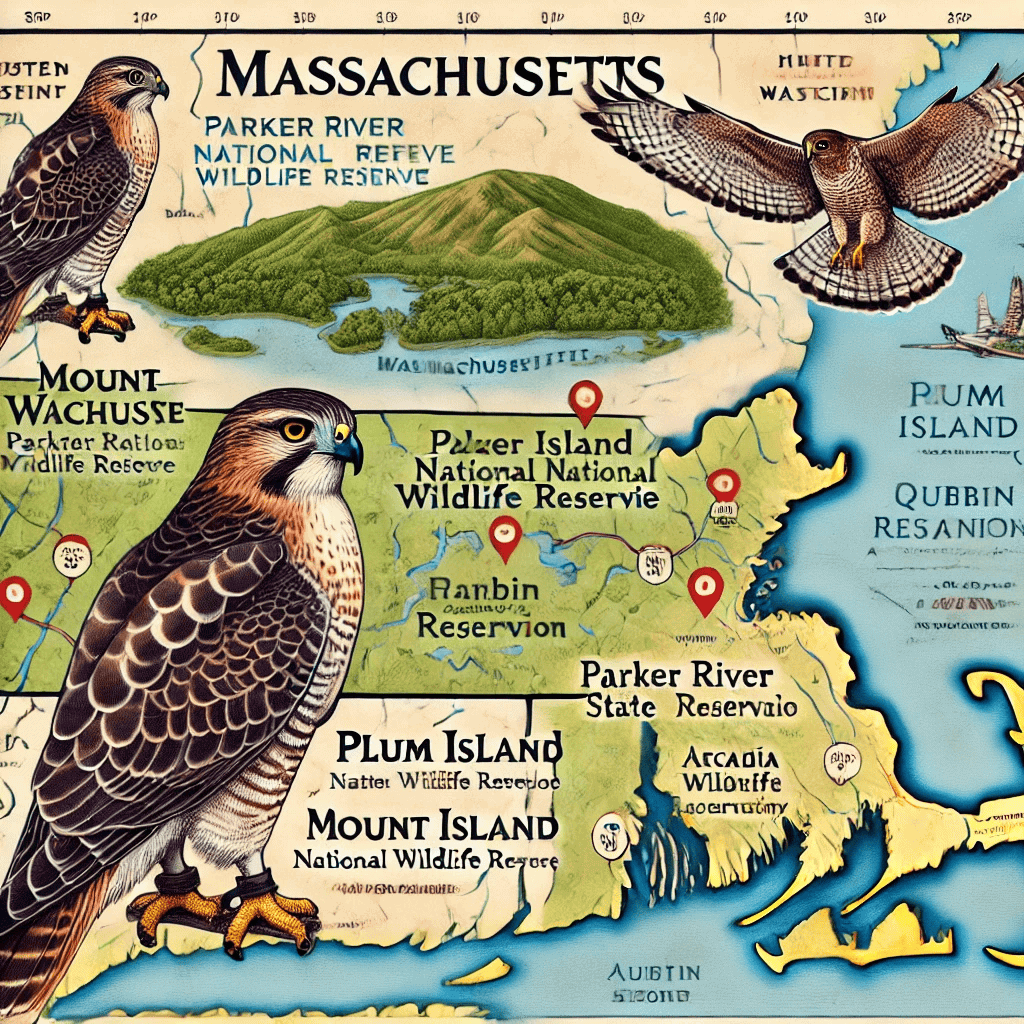
Choosing the right hawk-watching spots makes the experience better. State parks with high grounds are great for viewing. Some top places include:
- Parker River National Wildlife Refuge is known for over 360 species.
- Mount Tom in Easthampton is perfect for spring hawk watching.
- Plum Island, part of the Parker River Refuge, with diverse habitats.
- The Daniel Webster Wildlife Sanctuary in Marshfield is home to over 270 bird species.
- Wellfleet Bay Wildlife Sanctuary on Cape Cod, with nearly 300 species.
- Belle Isle Marsh Reservation is great for over 30 shorebird species.
Join the Valley Bird Festival for fun activities. It has guided walks, family fun, and live bird shows. Highlights include:
| Activity | Time |
|---|---|
| Bird Walk | 6:30 AM |
| Family Activities | 8:00 AM – 10:00 AM |
| Guided Bird Walks | 10:30 AM – 2:00 PM |
| Live Owl Demonstrations | 11:00 AM & 1:00 PM |
Visit New England Falconry in Hadley for a special experience. You can interact with Hawks with Master Falconer Chris Davis. With almost 500 bird species, Massachusetts is great for bird watching.
Conservation Status of Hawks in Massachusetts
The status of hawks in Massachusetts changes with each species. Many hawks have bounced back from pollution and lost habitats. For example, Broad-winged Hawks were once found in over half of certain areas. In the Taconic Mountains, they were in 93.8% of blocks.
Recent data shows a small increase in their numbers in the Berkshire Highlands. This is good news for some hawk populations.
But there are still challenges. In places like the Coastal Plains and the Bristol/Narragansett Lowlands, Broad-winged Hawks have decreased. This shows that we need to focus on saving their homes and working together to protect their habitats.
Red-tailed Hawks are another success story. They are common in Massachusetts and can live in cities. Scientists have used 140 million bird observations to learn about their habits, which shows that Massachusetts is doing well in protecting these birds.
It’s important to get people involved. By teaching others about hawks, we can help save them. We must keep working to protect these amazing birds in Massachusetts.
Threats to Hawks in Massachusetts
Hawks in Massachusetts face many dangers, which harm their numbers and the places they live. We must understand these threats to help protect hawks.
Habitat loss and rodenticides are big problems. These issues affect Hawks a lot.
Habitat Loss
Habitat loss is a big worry for hawks. Growing cities, bigger farms, and cut-down forests harm their homes, leaving hawks with less space to live and hunt.
This problem hurts hawks and the whole ecosystem. Hawks help keep rodent numbers down, which is important for the balance of nature.
Impact of Rodenticides
Rodenticides are another big danger. Hawks eat rodents that have eaten poisoned bait. This can be very harmful to hawks.
Hawks are at the top of their food chain. They can get very sick from eating poisoned animals. This can kill them and hurt their families.
We need to work together to help Hawks. We must save their homes and use safe pest control methods. This will help hawks stay safe in Massachusetts.
Read More🐦Related Articles:
| Owls In Oregon |
| Owls in New Jersey |
| Common Shelduck: Colorful Coastal Duck Species |
| Hummingbirds in Texas |
| How to Keep Squirrels Out of Bird Feeders |
Conclusion
We’ve looked at the amazing variety of hawks in Massachusetts. Each has special traits, from the common Red-tailed Hawk to the rare Northern Goshawk. These birds are key to our ecosystem.
Watching hawks fly is thrilling. It shows us how important it is to protect them. We must keep their homes safe for future birdwatchers.
Knowing about hawk challenges and conservation helps us help them. Let’s work to save their homes. This way, we can enjoy watching them and help our planet.

